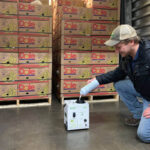Cities should aim to grow 30% of produce locally - report

Urban agricultural technology should be put into use to help produce at least 30 percent of cities’ fruit and vegetables by 2030, thus increasing food resilience.
This was one of the key points released in a report published by Tony Blair Institute For Global Change called “How cities can feed themselves - A Ten Point Plan”.
Both indoor vertical farms, which use hydroponics instead of soil, and precision greenhouses, which use artificial intelligence to analyze plants and adjust their growing conditions, benefit from high yields, frequent harvests, little water consumption and are not dependent on outdoor growing conditions.
Although they are most suitable for producing leafy greens and vine fruits, precision greenhouses are also currently experimenting with blueberries, raspberries, strawberries and other fruits. In addition, urban gardens can grow all types of fresh fruit and vegetables.
Growing crops using traditional seasonal methods has been affected by a number of factors: climate change, complex supply chains, labor shortages, political instability and global crises.
Two thirds of the world’s population are predicted to be living in cities by 2050 and consuming 80 percent of all food produced, so there is an evident need for fresh, healthy and locally sourced fruit and vegetables.
Singapore has already implemented its “30 by 30” initiative and European cities also aim to grow between 25% (Paris) and 30% (Brussels) of food by 2035 and 2050, respectively.
Urban agtech uses lots of energy, so it is ideal for places with access to sustainable energy. In particular, precision farming tools can be used in cities with high food imports and places where labor is scarce, as well as peri-urban areas, where land is vast and cheaper.
The “Ten Point Plan” clearly states that urban space must be viewed as an agricultural asset. The role of progressive politics, through updated policies and financial support for research and development, as well commercial investment, using new and existing buildings for agriculture, are both key to bridging the gap to financial success.
Moreover, appropriate labeling, as well as education, should be prioritized.
At present, the U.S. Department of Agriculture’s Office of Urban Agriculture and Innovation Production has provided 10 million USD in grants and the National Institute of Food and Agriculture funds genomics research.
Investments in agtech start ups are soaring, with some companies going public, and U.S. companies like Appharvest, Benson Hill and Bowery Farming are amongst some of the key players in the controlled-environment agriculture industry.








































